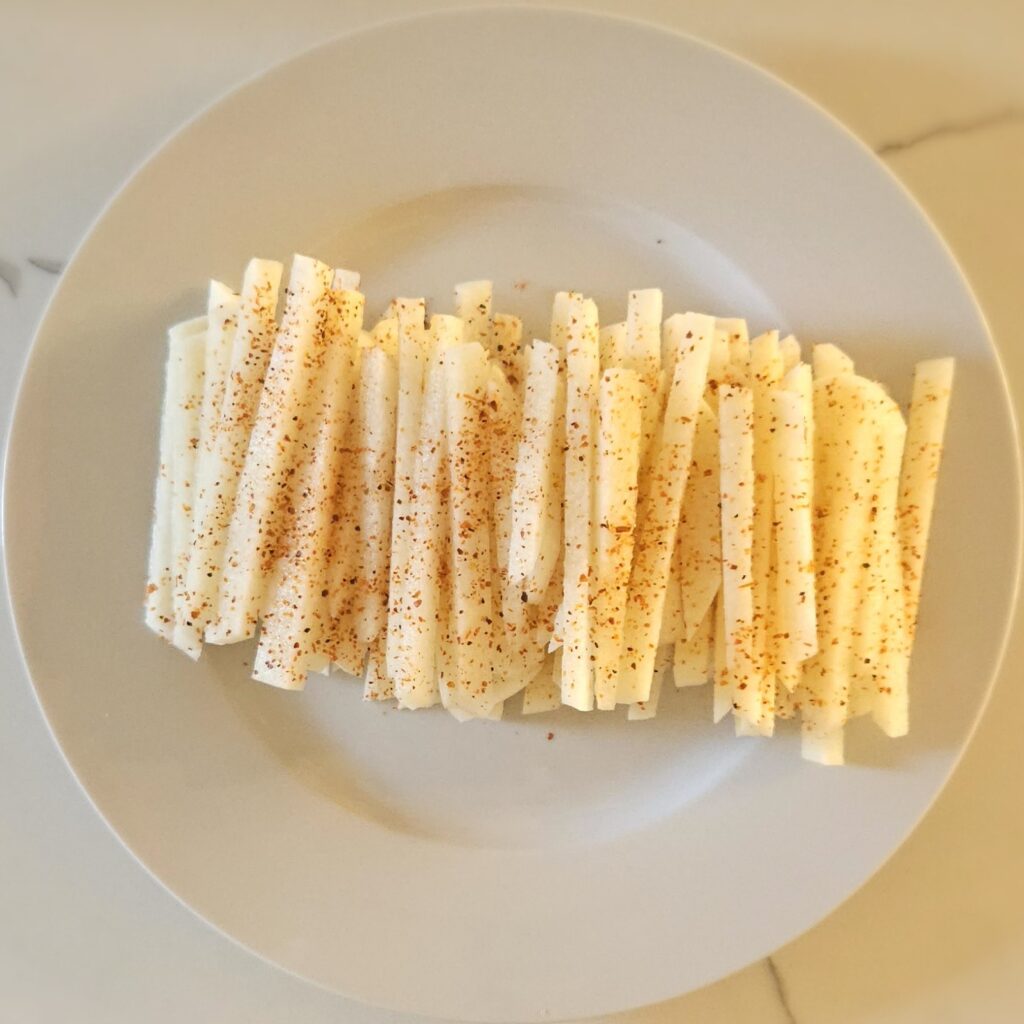
This one is new on me, but I am immediately head over heels! I love hot fries but my feelings about processed foods and hydrogenated oils are quite a different story. Enter jicama (pronounced “hic-um-uh”). It’s a root vegetable like a potato, but instead of starch, it contains inulin! (You’ll read more about that below.) It has a very neutral taste so what you experience is a very refreshing crunch that is hard to stop eating. I’m completely sold. So, again, I’m going to start you off with the nutrition facts and the recipe itself to make it easy for you to find. Of course the nutrition info is also in Myfitness Pal under the brand Thrive Cooking. But I really hope you’ll scroll a little past the recipe to check out the interesting info that I dug up about this little guy. It’s almost as good as this snack itself! (And check out this guy’s video about it.)
Nutrition Information
| SERVING SIZE 3/4 C (1/4 Jicama) | (although I can honestly eat the whole thing) |
| Calories | 62.5 |
| Total Fat | 0.15 g |
| Saturated Fat | 0 g |
| Cholesterol | 0 g |
| Sodium | 6.5 mg (does not include seasoning) |
| Total Carbohydrates | 14.5 g |
| Dietary Fiber | 8 g |
| Sugar | 3 g |
| Protein | 1.175 g |
Prep Time 5 min | Total Time 5 min | Serves 1
Ingredients
- 1 Jicama
- Tajin or seasoning of your choice
Directions
1. Peel It.
This is easily done with a carrot peeler. I start by cutting the points off like when I’m working with an onion and just peel around the sides.
2. Cut It.
I prefer to eat it fresh each time so I only cut what I’m going to eat immediately and keep the other quarters in the refrigerator. You want them in the size and shape of fast food french fries.
3. Season It.
It doesn’t take much at all. Just sprinkle a bit of Tajin or any other seasoning on this and it will be perfect! Your belly is going to be so happy!
I’m Inducting This Into The Healthy Snacks Hall of Fame
Jicama, also known as Pachyrhizus erosus, is a root vegetable that belongs to the legume family, specifically to the Fabaceae family. While commonly consumed in Latin American and Asian cuisines, its biochemical properties and nutritional composition are less well-known but can be quite fascinating, especially when we dive into its chemistry and how it interacts with our body.
Basic Composition
Jicama is primarily composed of water (about 85-90%) and carbohydrates, with very low protein and fat content. This makes it a relatively low-calorie food, which is why it’s often favored in diets for weight management. However, the interesting part lies in the structure of its carbohydrates and its fiber content.
Carbohydrates and Starch
The main carbohydrate found in jicama is inulin, a type of fructooligosaccharide (FOS). This is a form of soluble dietary fiber made up of short chains of fructose molecules. Unlike other carbohydrates, inulin is not digested in the small intestine. Instead, it passes into the colon, where it serves as a prebiotic, feeding beneficial gut bacteria. This has several health benefits, such as improving gut health, enhancing mineral absorption (especially calcium), and even helping to regulate blood sugar by improving insulin sensitivity.
Unlike starches in potatoes, which are primarily glucose-based, inulin in jicama offers a different type of carbohydrate that doesn’t spike blood sugar levels rapidly. For people with diabetes or those trying to manage blood sugar, this makes jicama a preferable choice over starchy root vegetables.
Fiber Content
Jicama is also high in dietary fiber. The fiber content is both soluble (like inulin) and insoluble, which contributes to gastrointestinal health. Insoluble fiber adds bulk to stool, promoting regularity and preventing constipation. In addition to this, fiber has been shown to help lower cholesterol levels by binding to bile acids in the intestines and promoting their excretion, thus reducing overall cholesterol levels in the bloodstream.
Vitamins and Minerals
While jicama is low in fats and proteins, it does contain an impressive array of vitamins and minerals:
- Vitamin C: Jicama is an excellent source of vitamin C, which is crucial for the synthesis of collagen, a structural protein in the body. This vitamin also acts as an antioxidant, protecting cells from damage by reactive oxygen species (ROS), which are harmful by-products of normal metabolic processes.
- Potassium: Potassium is an essential mineral that helps maintain fluid balance and proper function of muscles and nerves. A higher potassium intake can help manage blood pressure by counteracting the effects of sodium. As a pharmacist, I must mention that this has so much potassium in it that people on certain medications should be aware of it. Talk to your doctor about this if you take an ACE inhibitor (e.g., enalapril, lisinopril), ARB (e.g., losartan, valsartan), Potassium-Sparing Diuretic (e.g., spironolactone, amiloride, triamterene), Aldosterone Antagonist (e.g., eplerenone), certain blood pressure medications (e.g., aliskiren), NSAIDs (e.g., ibuprofen, naproxen- they can reduce the kidney’s ability to excrete potassium), or Heparin (may raise potassium levels in the blood). Potassium levels can be tricky in some patients and it plays a critical role.
- Folate: Folate, or vitamin B9, is important for DNA synthesis and repair, and it plays a key role in cell division and growth. It’s particularly important during pregnancy to prevent neural tube defects in the developing fetus.
Phytochemicals
One interesting aspect of jicama is its antioxidant content. Jicama contains phenolic compounds, such as flavonoids and polyphenols, which have antioxidant properties. These compounds help neutralize free radicals in the body, which, if left unchecked, can cause oxidative damage to cells and DNA, contributing to aging and diseases like cancer. However, the levels of these compounds in jicama are not as high as in other fruits and vegetables, but still contribute to its overall health benefits.
Water Content and Hydration
Given its high water content, jicama can be very hydrating. It’s often used in refreshing salads or eaten raw as a snack. The high water content also contributes to its low calorie and low glycemic index (GI) properties, meaning it has a slow, minimal impact on blood sugar levels, making it suitable for those with insulin resistance or diabetes.
Effect on Gut Microbiota
As mentioned earlier, the inulin in jicama acts as a prebiotic. Prebiotics are non-digestible food components that benefit the host by stimulating the growth and/or activity of beneficial microorganisms in the intestines. These beneficial gut bacteria help break down food, produce essential nutrients like short-chain fatty acids (SCFAs), and support immune function. When these bacteria ferment inulin, they produce SCFAs such as butyrate, propionate, and acetate, which nourish the cells lining the colon and promote a healthy gut environment. (Read more about that here.) Additionally, this fermentation process may help reduce inflammation in the gut, which is linked to various chronic diseases.
Glycemic Index (GI) and Insulin Sensitivity
One of the key reasons jicama is considered a healthy option for those monitoring their blood sugar is its low glycemic index (GI). The GI is a scale that ranks carbohydrates on how quickly they raise blood glucose levels after consumption. Foods with a low GI (below 55) have a slower effect on blood sugar levels. Jicama, due to its inulin and fiber content, has a GI of about 15, which is very low. This means that jicama releases glucose into the bloodstream gradually, preventing spikes and crashes in blood sugar.
This characteristic of jicama makes it particularly beneficial for individuals with diabetes or those managing metabolic conditions like insulin resistance. The slow digestion of its carbohydrates helps improve insulin sensitivity, a crucial factor in managing type 2 diabetes.
Potential Medicinal Uses
There is ongoing research into the medicinal properties of jicama, particularly due to its high inulin content and its potential benefits for gut health. Studies suggest that inulin can help lower triglyceride levels and reduce cholesterol, which could have implications for cardiovascular health. Additionally, some animal studies have shown that jicama might have anti-inflammatory effects, which could help in managing conditions like arthritis or inflammatory bowel disease (IBD).
Conclusion
Jicama is a nutritionally rich food with an impressive biochemical profile. The high water content, coupled with the presence of inulin, dietary fiber, antioxidants, and key vitamins, makes it a great food for promoting digestive health, improving gut microbiota, managing blood sugar, and supporting overall metabolic health. Its versatility and low-calorie nature make it a valuable addition to many diets, particularly for those with specific health concerns like diabetes, high cholesterol, or those trying to maintain a healthy weight. By understanding the biochemistry behind jicama, both professionals and enthusiasts can appreciate its importance beyond just being a crunchy, refreshing snack.
So give it a try! Even a small change like replacing one processed snack with something natural can have an impact on your health. Instead of feeling unimpressed with yourself for accidentally eating almost the whole bag of hot fries (guilty as charged), you’ll actually feel nourished and taken care of. Do that for yourself!



